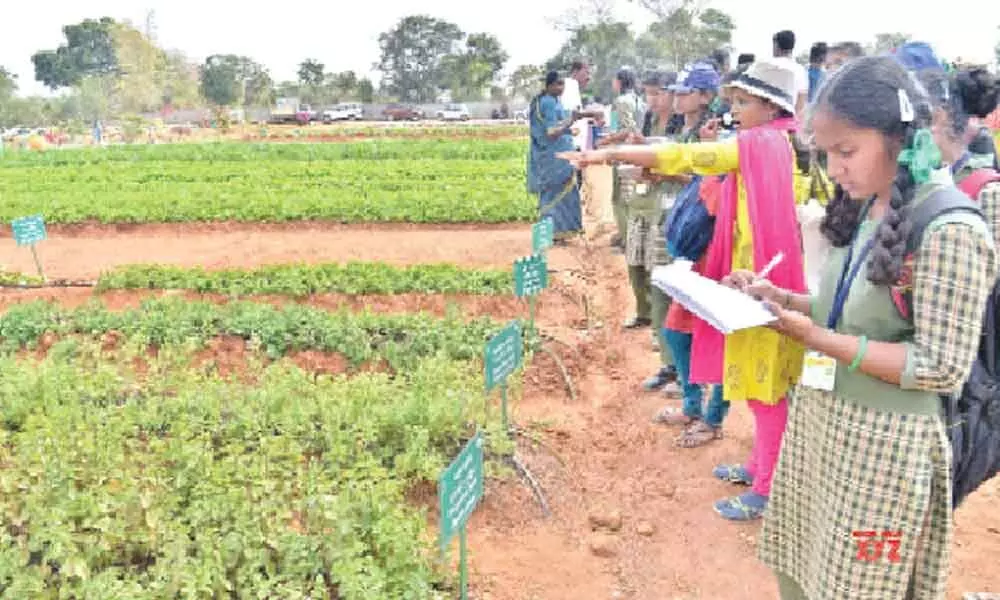Live
- Employability skills programme concludes
- Govt plans to establish offshore Johns Hopkins University Campus in India
- Goa Aces clinch Indian Racing League title
- Study finds how hormone therapy can reshape the skeleton
- High-street fashion players looking at India for manufacturing: Report
- Shreyas Iyer to lead Mumbai as Prithvi Shaw returns for Syed Mushtaq Ali Trophy
- 'Failed to resolve crisis': NPP withdraws support from BJP govt in Manipur
- Chennai: Actress Kasturi Remanded in Custody Until 29th of This Month
- Aaqib Javed likely to become Pakistan's new white-ball head coach
- BJP panel to draft poll charge sheet against AAP govt in Delhi
Just In
IIHR-Bengaluru develops disease resistant chillies


IIHR-Bengaluru develops disease resistant chillies
City-based ICAR-Indian Institute of Horticultural Research (IIHR) has developed disease resistant green chilli varieties which will drastically cut the production cost by nearly 40 per cent to 50 per cent, if these varieties are grown scientifically.
Bengaluru: City-based ICAR-Indian Institute of Horticultural Research (IIHR) has developed disease resistant green chilli varieties which will drastically cut the production cost by nearly 40 per cent to 50 per cent, if these varieties are grown scientifically.
Principal scientist, ICAR-IIHR's Vegetable Crops Division, Kambham Madhavi Reddy said that virus-resistant chilli varieties were result of an intensive research efforts for nearly a decade. She has played a vital role in developing Arka-Tejasvi, Arka-Tanvi, Arka-Sanvi, Arka-Yashasvi and Arka-Gagan. "Most of these varieties can be grown across the country," she said.
"Chilli crop is impacted heavily by the weather as it is mainly cultivated during Kharif season for dry chilli purpose. During Rabi and summer season, green chillies are cultivated. For the rain-fed cultivation, rainfall distribution plays a major role," she said and added that chillies are prone to diseases and are highly susceptible to pests.
According to her, the disease-resistant varieties would bring down the use of pesticides and use of drip irrigation and other scientific methods, a farmers can easily reduce production cost by at least by 40 per cent and it can be up to 50 per cent also.
She added that half the battle is won with regard to farming when a disease-resistant variety is discovered.
"The major pests are Thrips, Mites and Gall midge. Some of the major diseases are fungal which is a powdery mildew, 'Phytophthora' root rot and Aanthracnose fruit rot," she added.
According to her, the chilly crop is also widely affected by viruses like Cucumber mosaic cucumovirus (CMV), Chilli veinal mottle potyvirus (ChiVMV), Chilli leaf curl virus (ChiLCV) and Groundnut bud necrosis virus (GBNV).
"These viruses are very problematic and pose serious threat to chilli crop production as the vectors are surging due to their wide adaptability to climate change," she added.
Most of the viruses systemically infect the host, after invading cells they express their proteins replicate and move from one cell to another.
"India's chilly exports valued at about Rs 6,000 crore. In the event of the production cost comes down, the value might go up further and it can reduce crop wastage to a large extent," she explained.
In Karnataka chilli growing area is estimated to be around two lakh hectare and several farmers can benefit. "Madhya Pradesh which is traditionally a green chilly producer, is now slowly taking up red chilli cultivation too. As farmers of this state have realised how much a red chilli crop can offer to them. Red chilly is most sought after produce by the pharmaceutical, cosmetic and food industry too," she explained.
The principal scientist feels that with the existing varieties that are available in the market, cost of production comes up around anywhere between Rs 75,000 to Rs 1 lakh and if the cost of production comes down even by 40 per cent, it is a huge saving.
"This is one of the ways how farmers can double their income," she claimed.

© 2024 Hyderabad Media House Limited/The Hans India. All rights reserved. Powered by hocalwire.com






